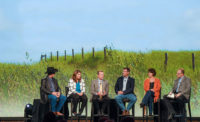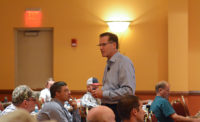In the heart of South Dakota — a state ranked fourth in yearly Angus registrations, where cattle outnumber people four to one — there’s been a bit of a desert for marketers of high-quality fed cattle.
Many finished animals are still shipped to neighboring states for processing, but DemKota Ranch Beef, a packing plant in Aberdeen, S.D., is looking to keep a higher percentage of them close to home.
Recently signing on as the first and only plant in the state to license with the Certified Angus Beef (CAB) brand, it produced the official first pound for the brand the first week of April.
“We’re excited about focusing on more of a relationship with our local feeders and truly getting this plant to meet the goals those initial investors envisioned,” says Todd Landfried. The vice president of branded/export sales and marketing for DemKota notes the plant was built on hopes of supporting the state’s feeding industry and its cow-calf suppliers.
Opened in 2012, the plant is now operated by its third owner, New Angus, funded by San Francisco-based investment firm White Oak Global Advisers.
“The cattle industry is looking very favorable for the next three, if not four or five years, and we’re in the middle of cattle country,” Landfried says. “Our advantage is that corn is plentiful and cheap in this market. Diets are very similar from feeder to feeder, so you’re going to get a consistent taste bringing it in from a small region like that.”
Today, the company sources cattle from a 250-mile radius of Aberdeen, but plans are to reduce that circle as the business moves to a higher percentage of fed cattle in the 1,250-head daily harvest.
“We were killing cutter and canner cows, just to train the work force. Then as we evolved, we moved to white-fat cows and then to fed cattle,” Jeff Russo, DemKota vice president of procurement, says. “For the fed cattle, we’re looking at high-quality black cattle.
“We’ve been about 80 percent black hided and at least 80 percent Choice and higher. Our goal is to have as minimal yield grade fours (YG4) and fives as we can,” he says, explaining the target.
The company has invested in a professional sales force, building a strategy around independent specialty meat companies and branded sales.
“The mature cattle program will always be an important part of our portfolio as we focus on growing the under-30-month fed program,” Landfried says. “As we ramp up our Angus fed program, it’s about those relationships we currently have in place and giving them more of a consistent volume.
“We envision working with these partners to make sure they’re putting high-quality cattle on feed that come from a good genetic background,” he says.
Currently most cattle are sold in the beef and cattlemen get that carcass information back they can use to benchmark their herds.
Russo says DemKota is competitive with bids, and there’s freight savings, but they can’t take all the area cattle.
“We only have so much shackle space,” he notes.
In order to reach the plant’s 1,500 head-per-day floor capacity, DemKota would need to invest in more cooler space, so the near-term target is to reach 1,300 head, Landfried says.
“As we get more of a database, we’ll sort out who has the best cattle and they’ll be the first priority,” Russo says. “We want to get the best ones here.”
Clint Walenciak, CAB director of packing, says he is looking forward to the growth of DemKota’s fed business and the partnership between the two companies.
As a point of differentiation from other licensed processors, DemKota sells the brand in a dedicated CAB box, solid-color with a prominent logo, so the beef stands out among a sea of brands.
“There are very few in the industry putting out a branded CAB box,” he says. The product is the same across all facilities, but to certain customers that upscale packaging is a selling point.
“When they trade in these premium programs, and other competing brands have nice-looking boxes, they want the largest premium branded beef program to have packaging that matches our strict specifications.”
What’s good for the brand is also good for producers in the Angus-heavy state, Walenciak notes.
“Their licensing allows us to tap into a great supply of cattle that are high-percentage Angus and typically grade very well,” he says. NP






Report Abusive Comment